It is rare to find a board game that takes more than an hour to win, and less than ten minutes to lose. Yet somehow Matt Leacock has managed it in the emotional rollercoaster of a cooperative survival game known as Forbidden Desert.
Many aspects of this game are carried over from its prequel, Forbidden Island, but do not let that fool you. This sequel is no simple reskin of an older game. Leacock took all of the amazing parts of Forbidden Island and added a number of twists and complexities that really bring this desert to life.

Crash Landing in a Dangerous Desert
In Forbidden Desert, the players form an intrepid group of Indiana Jones-style archaeologists whose helicopter was knocked from the sky by a sudden, mysterious desert storm. Now, with the sun beating down and the sandstorm threatening to bury them alive, they must find the scattered remnants of an ancient flying machine. With the pieces gathered, each member of the archaeology team must meet at the landing pad. Only then can they escape the ravages of the desert storm.
Oh, and did we mention that literally everything is buried in sand? That’s right. Each piece of the flying machine, and even the landing pad are buried under mountains of sand from the start. Not to mention that the storm is constantly dumping even more sand on top of it. So get your shovels and sunscreen, and let’s start excavating!
Our Probably-Heroic Protagonists
Each player will be exploring the desert as one of several unique adventurers. Though it is not explicitly stated there are strong hints that these are the same unlucky (and probably cursed) adventurers who just escaped a particular sinking island. Should have stayed away from those cursed relics.
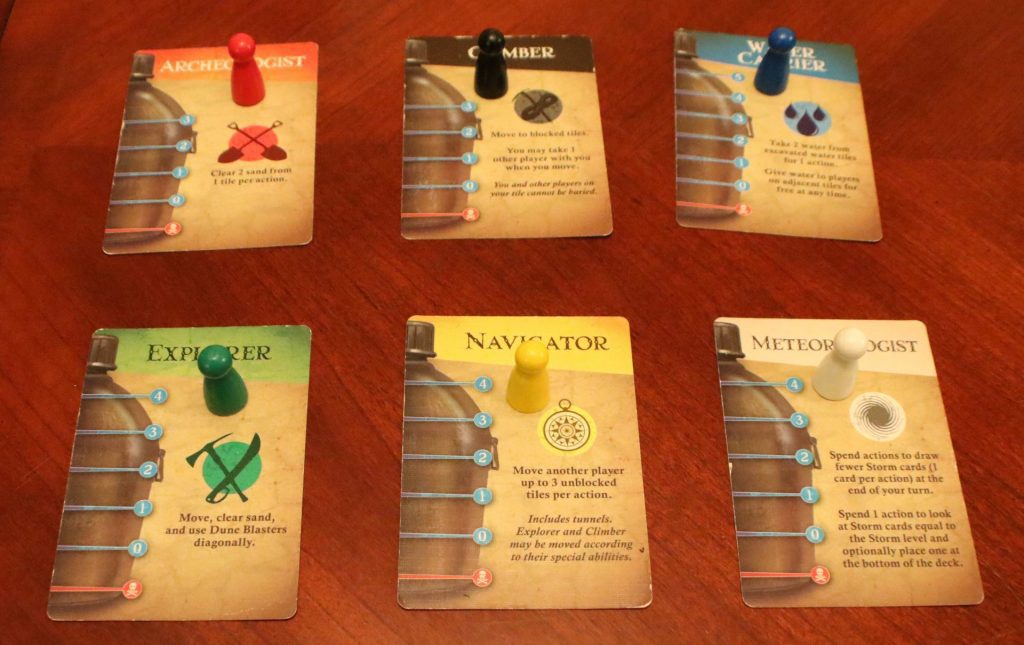
Adventurers will spend each of their turns using actions to move around the desert, shovel sand, excavate tiles to find equipment or clues, or (if they are lucky) pick up a piece of the flying machine. Each adventurer also has access to a special, unique ability, giving each player a distinct experience and role throughout the game. Finally, each adventurer has a water counter to keep track of how much water they have left. This will become VERY important very soon.
Assembling the Flying Machine
With the team assembled, it is time to start building the flying machine. In order to locate one piece of the flying machine the players must excavate two separate clues. Only when both of the clues are unearthed does the true location of the artifact become visible. Even then, the adventurers must travel to the artifact in order to pick it up, which becomes more and more difficult as the storm progresses.
The Storm
Of course, finding some clues and picking up some artifacts is not difficult by itself. Which brings us to the storm. This is the most exciting (and infuriating) part of Forbidden Desert. It is also the reason that games can last as long as a couple hours or as short as ten minutes.
Conceptually, the storm is simple. At the end of each of your turns, you draw a number of storm cards indicated by the storm counter. These cards have one of three effects.
First, and most common, they move the storm. This is often confusing at first, but ends up being one of the most exciting (and nerve wracking) parts of the game.

The storm is the hole in the board (though we enjoy placing the Storm Counter in the hole to represent the storm). It’s the one place where adventurers cannot move. The Storm begins the game in the center of the board, but will end up touching almost every tile before the game ends, leaving a horrible swath of sand in its wake.
This sand blocks access to tiles (indicated by the “x” on the back side of the tile) and prevents you from excavating the tile or picking up a piece of the flying machine until all the sand is removed. And if you ever need to place a sand tile but have none left, you lose. Everyone is buried in sand.
When you draw a Storm Card that moves the storm, it will display a number of squares and an arrow. This tells you how far, and in what direction, the storm moves (as little as one square or as many as three).
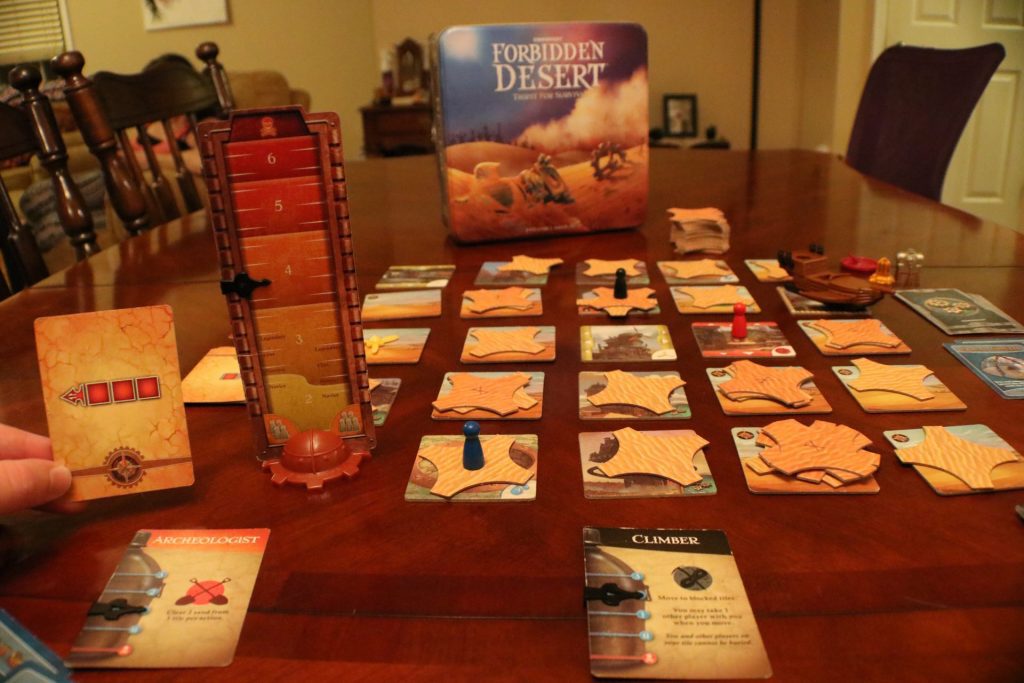
As the storm charges around the board (and it charges a LOT), it shuffles the tiles around. This means that the board is constantly changing, and a clear path on one turn can become completely and utterly blocked on the next.
The second type of storm card is the dreaded “Sun Beats Down”. When this card is drawn everyone who is not shaded from the sun (by either a tunnel tile or a Sun Shield) decrements their water counter.
And this is how adventurers die; after all, many characters only have a maximum of 3 water. If the sun beats down while you have no water left, you die; if you die, everyone loses. Yikes!
The final type of Storm Card is the dreaded “Storm Picks Up” card. It increases the level of the storm on the Storm Counter, eventually causing you to draw more storm cards at the end of each turn.
If you are not careful, a Storm Picks Up card can outright end the game. If the Storm Counter ever gets up to the skull and crossbones, everyone is blown away by the storm, never to be seen again.
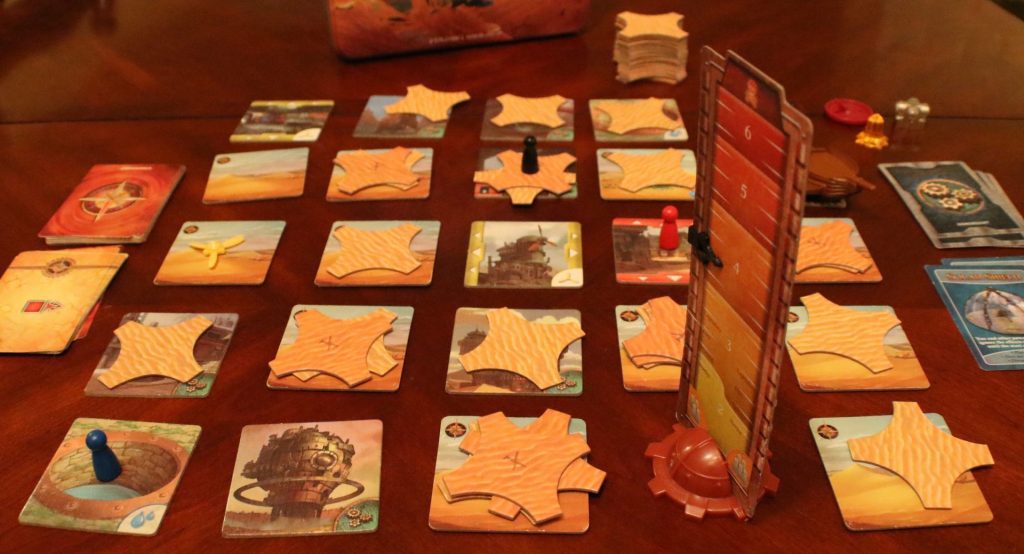
Final Thoughts
The Good
The storm’s constant shuffling and blocking of the tiles that make up the board is nerve wracking, and its unpredictability adds a genuine element of suspense to the game.
Beyond just the storm, Forbidden Desert’s assortment of heroes are each exciting and interesting to play. The exact characters that you choose have a dramatic effect on the way that the game plays out. This variation adds a lot of replay value to the game, since your strategies change drastically depending on the adventurers in your party.
The number of players in the game also drastically changes the flow of the game. With only two players, the turns pass quickly. A team of two must function as an efficient machine if they are to have any hope of keeping up with the storm. Interestingly, adding players to the group does not necessarily make the game any easier. In fact, it frequently makes the game much harder.
Forbidden Desert also does a good job improving on the art and piece design from its predecessor. Though some of the ideas are similar, such as the cardboard tiles of the board and the character cards, the game as a whole is more aesthetically pleasing. Each desert tile’s underside has a unique art design representing a part of the city that can be a lot of fun to discover for the first time.
The pieces are also well made. Even after several years, the pieces in my own copy of the game are quite nice, despite joining us on several vacations. Even the flying machine and its pieces are fun to look at and hold. The box itself is also pretty, but I will talk more about that below.
The Bad
Though Forbidden Desert can be quite fun, there are some aspects of its design that can be frustrating.
First and foremost among these is the game box, which is easily the most frustrating part of the game for my wife and me. At first glance, the box is quite pretty visually. It is made of metal, which is shiny and fancy and nice. This would be cool, except that the lid has the grip strength of a broken paperclip. That is to say: none.
So if you ever bring it anywhere, you have to make sure it stays upright, because that lid will do nothing to keep your pieces from scattering across your back seat or closet floor. Because of this, my wife and I are almost out of the little plastic clips that mark water and storm progression, and have lost nearly every other piece of the game at various times.
Other than the box lid, there is only really one somewhat frustrating aspect of the pieces themselves. The black clips that attach to the storm tracker and character cards have two issues. First, they are tiny, black, plastic clips. If you drop one in a dark place (like, for example, when your box lid opens and spills the contents of the game all over your trunk while you are on vacation in North Carolina…) you can expect to spend at least 15 minutes searching for these little things, if you find them at all.
Second, the clips are actually quite tight. While this allows them to avoid sliding around while clipped to a card or the storm tracker, it also tends to fray the edges over time. Especially on the storm tracker, since it is so much thicker than the character cards.
Thankfully, this is where most of Forbidden Desert’s issues end. Still, there are a few mechanical things that you should keep in mind if you are thinking about purchasing a copy for yourself.
As a cooperative survival game, Forbidden Desert requires a ton of teamwork. This is great, and is one of the reasons that my wife and I love the game so much, but only if everyone in the group is feeling cooperative. If you have a player or two who are particularly domineering, or not particularly invested in the game, it can start feeling like a single player game.
Another interesting but potentially frustrating aspect of Forbidden Desert is the brutal randomness of the storm. Because it is a cooperative game, if one person dies, everyone loses. Often, all it takes is two Sun Beats Down cards shuffled next to each other to bring the adventure to a very sudden end.
At the same time, it is possible to have a game where you spend the whole time desperately shoveling sand to stay alive, all the while making little to no progress toward victory. While this can lead to a very satisfying victory, it can also be quite frustrating, or even boring.
I still remember one night my wife and I were playing, and we lost four games in the course of about an hour, before finally winning one another hour later. This game is an emotional rollercoaster.
Conclusion
Forbidden Desert is a blast to play with an energetic, friendly group. It encourages group thinking, teamwork, and discussion, and is pretty to look at. It sits at a solid middle ground of complexity: simple enough for new gamers, but complex enough for tabletop experts.
It is not perfect, but Forbidden Desert really does a great job of learning from its predecessor, removing some of the more frustrating elements of the first game and replacing them with interesting strategic choices. If you enjoy cooperative games that are easy to learn and difficult to master, then this game is definitely worth a try.
Be ready though. The storm does not take kindly to trespassing adventurers.


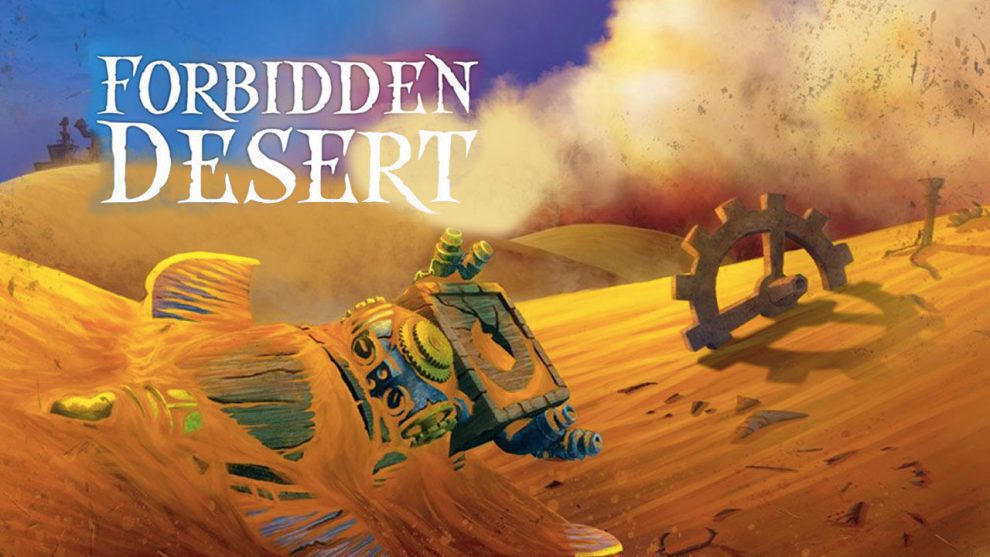
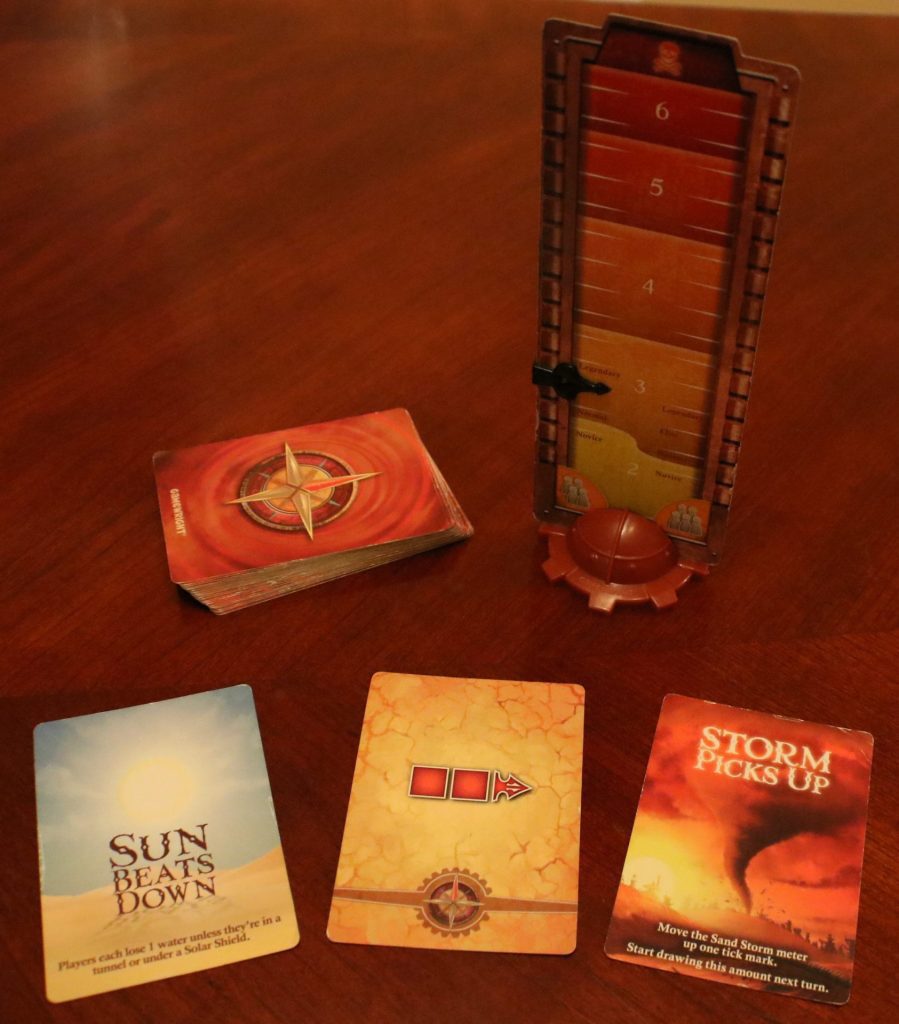




Add Comment